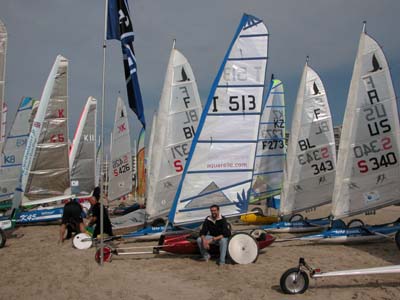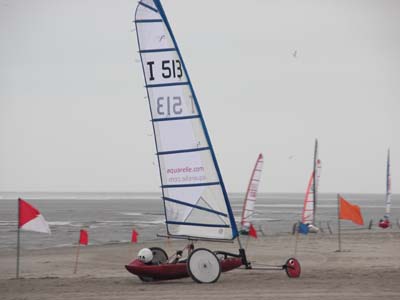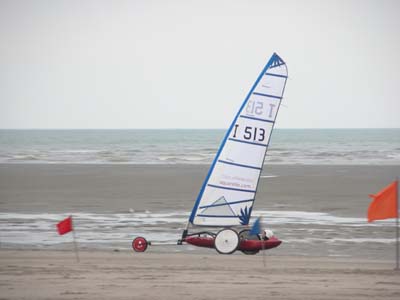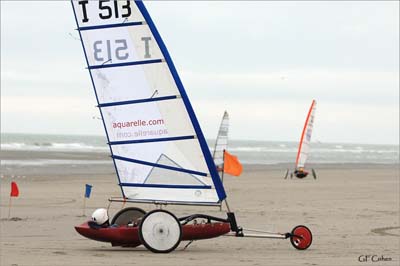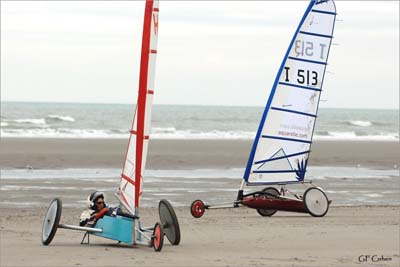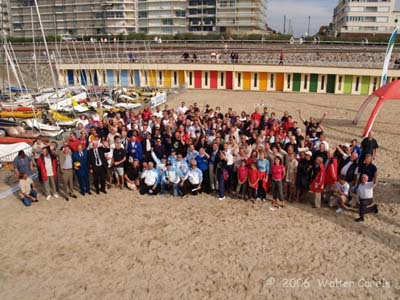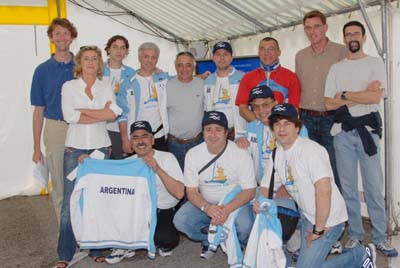

le touquet
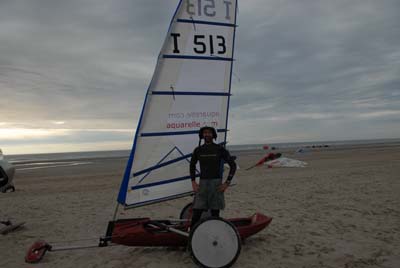
i keep on maintaining that the best way to make progress is under constant pressure: you learn things out of necessity (Right, I’m just applying Uncle Darwin’s theory to myself). In 2000 at Terschelling I didn’t worry so much about sailing with a Standart. But this time it is a Class 5, and I don’t have enough time to explore the beach on which we are going to compete as well. I soon find out that at Le Touquet you can’t turn yourself into a Class 5 pilot: it isn’t the ideal coupling for people like me, sailing a landyacht just a few weeks a year.
Photo Oliver Salvan
class 5 landyachts are formed by a chassis composed by big welded metal pipes into which the aluminium pipes supporting the highly inclined rear tyres and the front wheel are inserted. Connected to the chassis there is a composite monocoque into which the pilot lies down. An aluminium mast with circular section and a 5,5 m² sail complete the technical card. It must weigh minimum 50 kilos. The yacht given me by Hubert Queval is an Adves built by Pierre Cornuwel. Hubert, who is going to come fifth in the overall ranking, is sailing with a similar yacht, but his is definitely fresher than mine. I have no chance to try the landyacht and the sand until the first run starts. The wind is feeble and after a while it falls, but my first impression strengthens what everybody told me: sailing with a Class 5 is really, really hard. I’m pushing and zigzagging at the same time to gather speed because the pedals of the steering gear are really far away and it takes me some time to understand that until I lie down the only way to steer is using the starting handles connected to the front wheel which are on either sides of the landyacht. Now that I’m racing slowly, I realize that in competition trim visibility is very poor.
Photo Oliver Salvan
next day the wind has increased and I set a smaller sail, I feel like going fast but I also want to be in control of what is going on. There’s only one word explaining this first Class 5 run: FURY. Apart from the strength of the wind, the regatta seems to be a piece of cake: the wind is abeam, there isn’t much I can invent. So much the better, because this is my first time here and I have to think about…ABOUT WHAT? I do not think about nothing else except keeping contact with those who are before me.
Photo Oliver Salvan
for little more than 35 minutes (the length of the race fixed by the sailing master) I’ve been living in a tunnel and my horizon includes a very little stretch of beach, shells, water, the little sails of the landyachts sailing in the opposite direction which become larger and larger, the wheels of the other yachts coming close to mine and a pilot (one of the big ones) shouting to me to give way. Is my sail set? I have no time to check. Where am I now? I know that when the tide is low there are two sandbanks divided by a depression and other cross channels and that in some areas you can go from a sandbank to the other one without too many jolts. One of these areas should be where the first set of coloured bathing hut finishes, but how can I turn to look where those fucking huts are? Try to find the delta, try to find the delta…It would have been better to come some days earlier to explore this place, instead of being here and receiving these terrible blows all over my body. Something has happened to the landyacht: I hear the streamlined bottom of the hull scraping against the sand. Some other tacks to get to the buoys (with their signal flags getting closer at very high speed), then the turning point (and I have to hold on to the edge of the yacht) and finally the chequered flag, it’s a pleasure to see Stanislas waving it. On my arrival I can see a lot of dark faces around me: the FFCV delegates, Hubert, Pierre Cornuwel, the manufacturer of my landyacht. The chassis has cracked where the pipes sustain the rear wheels: the frame has opened up and therefore the yacht has lowered of about ten centimetres. Cornuwel has to work the whole night to make a lovely lacework in steel on the chassis to give me the opportunity to sail next day.
Photo GF Cohen
the line-up on the starting line is at 8 o’clock, but we are not able to complete the assembling in time. I get to the briefing when it is almost finished and as the rules prescribe I can’t take part in the regatta. Actually, things are better like that, because my yacht has been assembled too quickly and so I take this opportunity to set the pedals (the bar struck against the monocoque and turned with difficulty) and hoist the 5,5 m² sail for the second run of the day. There is a gentle wind, always abeam. I often have to get off and push. I realize that the wheels are opened up and toed in, I don’t know weather it is due to a hole or to the assembling done in a hurry. The wheels encounter a lot of friction but I can keep on sailing and go on with my apprenticeship. Anyway, I sail carefully, I don’t want to cause greater damage. Vincent, one of the French team, helps me to set the trim of my yacht with a ‘liner’, a tool used to get the right adjustment of the inclination of the wheels, which depends on the kind of chassis as well.
Photo GF Cohen
next day the direction of the wind changes, now it is blowing from the south and therefore the regatta will be more technical, with continual tacks and gybes. Towards the north, there is a spot where I’m forced to pass through, leaving the cones to the left: you get there at high speed and then…waaasssshhhh…you dive into a channel where the tide has left a pool of salt water over 30 centimetres deep. Just to remember I have to pay attention, I treat myself to a fine overturn: as in 2000 with the Standart, the windward wheel rises slightly and I try to ease out, but the sheet is stuck under my body. On Friday I should be on the beach but all the blows my neck and my back suffered are not counterbalanced by adrenalin any more. If the chassis has sagged, even though it was a little bit rusty, my body must have received a good blow too. I know that this is the World Championship, the ultimate expression of competitive spirit, but to me it is primarily a good opportunity to gain experience and have fun. What’s the point of taking a risk if you are out of form? I decide to watch the Standart regattas and other two Class 5 runs, while the wind is always blowing along the axis of the beach.
i take part in this event by chance, mostly because of the highly advantageous conditions offered by the FFCV (Euro 200 for the hiring of the landyacht, insurance and accommodation in a little flat; in addition to this sum I reluctantly have to add other Euro 300 to pay damages to the yacht), but it turns out to be the most demanding competition because of the racing ground, the kind of landyacht and the competitive spirit. And it is a deep experience too, because of the human relationships, beginning from my room-mates, which are really good: Ali, a very positive and tough man who organizes adventure travels in Djibouti, even with landyachts (www.aecveta.com), and Graham, a New Zealander, who is a real professional man, competitive and lavish with technical information. But we don’t have to forget the mythical figures in the world of landyachting: the legendary pilot and manufacturer Pierre Dumoury (who invented the “Banane”, a landyacht with the streamlined fairing where the wheels are arranged in the shape of a rhombus, just to give you an idea), Bertrand Lambert (who has been world champion for five times and the holder of the speed record up to the record of the Ironduck) and Christian Nau. As many among those who know him have emphasized, Nau is not at all a superman and yet he undertook extraordinary enterprises, from the solo crossing of the Sahara Desert sailing a landyacht to the crossing of the Falklands Islands using a bicycle equipped with a sail; he was able to raise the interest of mass media (he was famous for landsailing in Paris or on the motorways) and for this reason much of the success of this sport is due to him.
Photo Didier Lambert
all of this was a very friendly affair, a perfectly organized show full of cocktail parties, dinners, gala performances: the climax was reached with the 50-year celebration party of the Bleriot Club. As usual, I played the official role of the captain of the Italian team, raising the Italian flag during the opening ceremony and attending the meetings called by FISLY and FFCV. Trying so to catch what the future has in store for us: the likely introduction of a cheaper class (the 5 Promo) in the international competitions; the tremendous competition of the Blokart which doesn’t want to be part of FISLY; the nonchalance of the Indian delegate who said that in Gujarat there is an area to do landsailing which is as wide as Belgium; the first brochures concerning the next European Championship at Hoylake (Great Britain) and those regarding the next World Championship at Comodoro Rivadavia (Argentina).
for a detailed photographic report of the World Campionship 2006 in Le Touquet
GF Cohen
www.quelques-photos.com www.pbase.com/bleriotclub
Walter Carels
www.pbase.com/waltercarels
www.pbase.com/loiseaubleu
Didier Lambert
http://www.aeroplage.info
